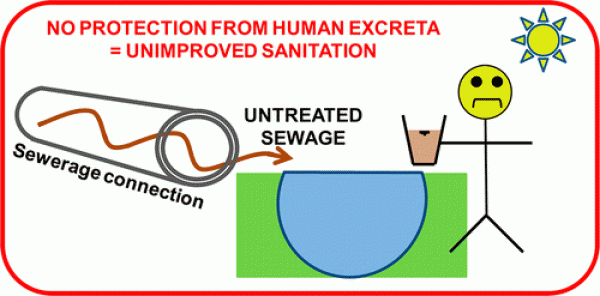Researchers from the University of North Carolina (UNC) estimate that the number of people without safe water and sanitation is much higher than previously thought. If you add actual service levels and the unreliability of some of the data to the equation the picture may be even bleaker.
Published on: 06/03/2013
Jamie Bartram’s team from UNC’s Water Institute calculated that 1.8 billion people (28% of the global population) used unsafe water in 2010 [1] and that 4.1 billion (60% of the global population ) lacked access to improved sanitation [2]. The corresponding official United Nations (UN) estimates are 783 million and 1.2 billion respectively.
The UN estimates are taken from the WHO/UNICEF Joint Monitoring Programme (JMP) [3]. The JMP definition of safe water is linked to the use of improved drinking-water sources. In their definition of safe water, Bartram’s team also looks at the water quality and sanitary risk of the improved sources. For their calculations, they modelled and extrapolated data from a WHO/UNICEF study on the Rapid Assessment of Drinking-Water Quality (RADWQ) in 5 countries.
However, water quality alone does not guarantee an adequate water supply. A study by Water Institute partner, the IRC International Water and Sanitation Centre, in 3 districts in Ghana revealed that more than 30% of the surveyed infrastructure was not functional, and as little as 2% was providing the basic level of service for which it was intended [4].

Just as with water, the JMP definition of “improved sanitation” only measures whether hardware – in this case toilets and sewerage - is in place. The Water Institute researchers classified connections to sewerage as “improved sanitation” only if the sewage was actually treated before disposal. Using data on sewage treatment in 77 countries, they developed an empirical model to estimate treatment prevalence for 47 additional countries [2].
It is not only definitions that under discussion. The reliability of JMP’s sanitation monitoring data was recently questioned by Szántó, Letema and Van Lier [5]. They analysed JMP data on the levels of urban sanitation coverage in East Africa from 2006, 2008 and 2010. Their conclusion: the massive change in coverage recorded over those 4 years was unrealistic.
The international WASH community is promoting universal coverage for water and sanitation in the post-2015 development agenda [6]. WASH Advocates CEO John Oldfield hopes that the UNC studies “will help us define what exactly we mean by ‘universal coverage’” [7].
[1] Onda, K., LoBuglio, J., Bartram, J. 2012. Global access to safe water: accounting for water quality and the resulting impact on MDG progress. International journal of environmental research and public health, 9 (3), pp. 880-894. (Link below).
[2] Baum, R., Jeanne, J. and Bartram, J., 2013. Sanitation : a global estimate of sewerage connections without treatment and the resulting impact on MDG progress. Environmental science & technology, 47 (4), pp. 1994-2000. (Link below).
[3] WHO/UNICEF Joint Monitoring Programme (JMP) for Water Supply and Sanitation (Link below).
[4] Adank, M., 2012. It’s about sustainable water services, not just about pumps and pipes : assessing and monitoring water services in Ghana. Powerpoint presentation World Water Week Stockholm 2012. The Hague, The Netherlands, IRC International Water and Sanitation Centre. (Available to download below).
[5] Szántó, G., Letema, S. and Van Lier, J., 2012. (Un)reliability in sanitation monitoring : analysis of East African urban data. Global water forum, 18 Dec 2012 (Link below).
[6] Catarina Fonseca, Universal WASH services that last in our time?, E-Source, 21 Feb 2013
[7] Brett Walton, Report: new sanitation figures compete with UN statistics for meeting Millennium Development Goals, Circle of Blue, 26 Feb 2013 (Link below).
Related news: